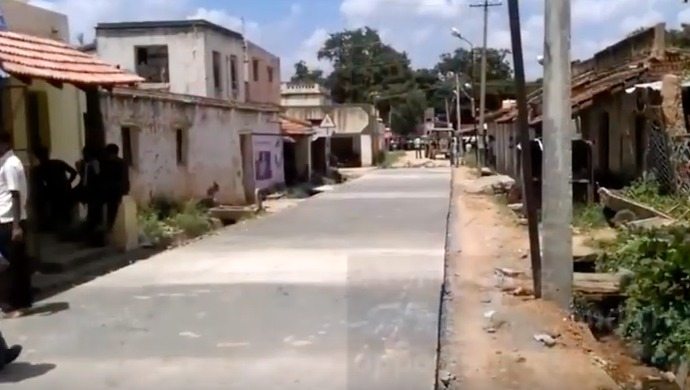The self-repairing road is just 100 mm in thickness, which is about 60 per cent less than that of a typical road. Less cement means less cost and less carbon footprint

Nemkumar Banthia’s the self-repairing road in Thondebavi village in Karnataka (Image Credit: Youtube video)
In rainy seasons in India, you may lose yourself in the labyrinth of the busy streets submerged and soaked in the heavy downpour. Commuting becomes exhaustive and you need to possess some acrobatic skills to not fall off the two-wheeler, or the ubiquitous auto-rickshaw you are travelling in, into the ‘small ponds’ on the roads, formed as a result of torrential rains.
The neglect and apathy of authorities make people so frustrated that at times they plant banana saplings in the potholes right in the middle of the road defying heavy traffic, to express their anguish and protest over the failure of regular maintenance.
Also Read: This Indian scientist grows solar panels on trees
In villages, things are even worse: roads are as rare as electricity or food. People can be seen walking the unpaved and dirty tracks for kilometres, carrying their ailing children or parents to the hospital, the scene straight out of one of those impoverished African countries.
And yet, for the outside world, India is a bright spot, at least on paper.
Now, the invention of an Indian scientist, settled in Canada, might turn things around for the better for the people of India or developing countries. Professor Nemkumar Banthia of Canada-India Research Centre of Excellence has blended structural engineering skills and material science to build a self-repairing road that is not only cost-effective, but has greater longevity.

Nemkumar Banthia (Image Credit: Globeseries)
Banthia, an IIT Delhi alum who is currently a professor in the Department of Civil Engineering at the University of British Columbia (UBC), has used ultra high-strength concrete and special fibres developed at UBC to make the magical road in his village in Karnataka.
Unlike the typical concrete road, for which cement is a key component, Banthia’s road uses 60 percent fly-ash and only 40 percent cement. The fibres used have a hydrophilic nano-coating, which attract water in the event of rains. The water then becomes available for crack healing. When a crack appears, this water gives hydration capability to the unhydrated cement, and produces further silicates which actually closes the crack in time.
The self-repairing road is just 100 mm in thickness, which is about 60 per cent less than that of a typical road. Less cement means less cost and less carbon footprint.
Banthia and his team claims that the road can last three times longer. They are now looking to take the concept to other parts of India and Alberta in Canada.
Also Read: Will Bangalore get its Silicon Valley tag soon? It’s unlikely with the woes remain unabated
The inaugural project, which connects the Thondebavi village to the highway in Karnataka, was built late last year. However, Banthia and the team waited for a year before trumpeting their achievement to the outside world to check the efficacy of the road. The magical road stood intact throughout the year and it did not melt in the extreme heat in summer or damage in the heavy monsoon downpour.
The invention is result of the hard work of Banthia, who has been actively pursuing research in the areas of cement- and polymer-based fibre reinforced composites, with particular emphasis on testing and standardisation, fracture behaviour, strain-rate effects, durability and development of sustainable materials.

The self-repairing road under construction (Image Credit: Youtube)
He is credited for his contributions to the fundamental understanding of sprayed concrete including particle and fibre kinematics, rebound modelling, in-situ quality control and performance characterisation. In the area of fibre-reinforced cementitious composites, he has developed a number of novel fibres for concrete and shotcrete (a mixture of cement sand and water) reinforcement, and these fibres that are now being used in numerous large projects around the world.
The post Attention! The road ahead of you is self-repairing appeared first on e27.